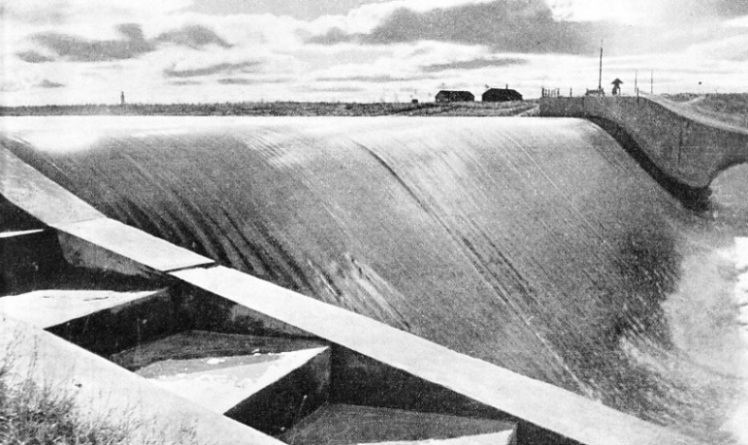


© Wonders of World Engineering 2014-


Lakes, rivers and canals have been linked by the Soviet Government to form a navigable waterway between Leningrad on the Baltic, and Soroka on the White Sea. The engineering works were carried out in severe conditions, with an unusual form of labour
THE WEIR OF SHAVANSK DAM, one of the fifteen dams built to control the waters along the line of the White Sea Baltic Canal. Great difficulty was experienced by the engineers responsible for the foundations of the dam. The weir is faced with timber, and the huge volume of water pours over it so smoothly that the water appears to be almost motionless.
WATER transport between the Baltic and the White Sea is effected along a waterway consisting of canals, lakes and rivers between the two seas. The main canal, which was opened in June 1933, extends for 142 miles from Soroka, on the Gulf of Onega, an arm of the White Sea, to Povyenetz, on Lake Onega, the second largest lake in Europe. There are nineteen locks, fifteen dams, twelve floodgates, forty dikes and thirty-
From Lake Onega the route to the Baltic is continued through waterways previously canalized to Lake Ladoga, which is the largest lake in Europe. In turn Lake Ladoga is linked by the River Neva with Leningrad, formerly known as Petrograd and as St. Petersburg when it was the capital of Imperial Russia. Leningrad is the largest of the northern ports of the Union of Soviet Socialist Republics, and is on the Gulf of Finland, an arm of the Baltic Sea. This last part of the route was available before the building of the White Sea-
To the average English-
up-
The geographical reason for the canal is partly explained by a reference to a map of Europe. Europe’s largest two lakes lie at the base of the long neck of land that connects the continent with Scandinavia, Finland and a strip of North-
Traversing the Soviet territory is the single-
Before the canal was cut all vessels bound from Archangel to Leningrad had to steam round North Cape and Scandinavia to get into the Baltic and then into the Gulf of Finland, a total distance of 2,840 nautical miles, or nearly the distance from Southampton to New York. The canal reduces the total distance to 674 nautical miles, which is a remarkable saving. Further, it affords a link with the Moskva-
There is another geographical advantage of the canal. The ocean coast of the huge territory of the Soviet Union fronts the Arctic Ocean and extends almost to North America. Soviet explorers have found an open-
Hence the White Sea-
The building of the White Sea-
Many of the trained engineers were in prison when the canal was decided upon. They were political offenders, and were not criminals in the general sense of the word. Many of the workers were also political offenders, although others were murderers, thieves and bandits from all parts of the vast country. Some came from places so remote that they did not speak Russian. Others, who were illiterate when they arrived at the site of the work, were taught to read and to write. After the completion of the canal, 12,484 persons were given their liberty, and the sentences of 59,516 persons were reduced.
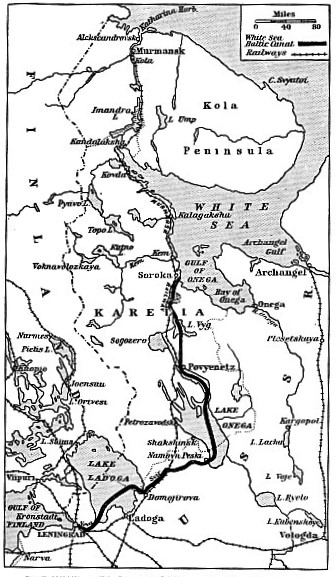 There is no unemployment in Russia as there is in highly industrialized countries. Therefore the Soviet Government was not displacing free men by convict labour. As the Soviet lacked steel, machinery and efficient transport, the authorities used multitudes of unskilled men and women to do work that is performed elsewhere by mechanical appliances controlled by skilled men.
There is no unemployment in Russia as there is in highly industrialized countries. Therefore the Soviet Government was not displacing free men by convict labour. As the Soviet lacked steel, machinery and efficient transport, the authorities used multitudes of unskilled men and women to do work that is performed elsewhere by mechanical appliances controlled by skilled men.
By means of all the instruments of propaganda the authorities strove to arouse enthusiasm among the workers. Every effort was made to appeal to the emotions, for the Russian is more temperamental than the Anglo-
THE WHITE SEA-
Such a system of labour caused complications. For each class of work a normal day’s output was established, and against this was set a certain amount of food. The worker referred to this output as his “norm”. If he did more he was given more food and more privileges. These extras were in accordance with the output exceeding the “norm”, which was fixed at 100 per cent. Further, the spirit of emulation was stirred by showing the output of each team of workers, and within that team the best worker was given a foreman’s job.
In the early stages some of the men were hard to convince. Those who refused to work stayed in the huts and generally became so bored with idleness and the remarks passed about them when the workers returned that they fell in line. There were occasions when teams faked the output by tricks such as piling broken rock on top of logs and claiming the whole pile as broken rock. Sometimes the output was faked so successfully that by the time those in charge had discovered the fraud the work was seriously behind schedule and strenuous efforts had to be made to save the situation. Also the competitive spirit was at times so strong that one gang was not above getting up in the night and taking wagons from a rival gang to increase its own output.
Apart from these peculiar difficulties the nature of the country and the climate were problems in themselves. The canal severs the rocky neck of land between Lake Onega and the White Sea in the autonomous State of Karelia. Information about the geology of the route was inadequate. In past ages glacial action had torn the surface and later the ground was forced upwards by subterranean pressure and further confused. The rock was on the surface in some places and at others wag covered by alluvial deposits, all under a layer of peat. In addition the climate was unreliable and there was not a month in the summer without frosts or a winter month without thaws. Also, the rise and fall of the rivers were uncertain.
In addition to these problems was the fact that an order was given that the canal had to be completed in twenty months. It was finished in one month over the time limit. The Government directed that the canal must be built to time, and that the engineers must apply simple designs and use raw materials to be obtained near the site. The main base was established near the southern end of the proposed canal. The first headquarters was just a railway coach on the Murmansk Railway, fitted up as an office. From this small beginning grew the nerve centre of the project.
Here and elsewhere along the canal wooden barracks, bath-
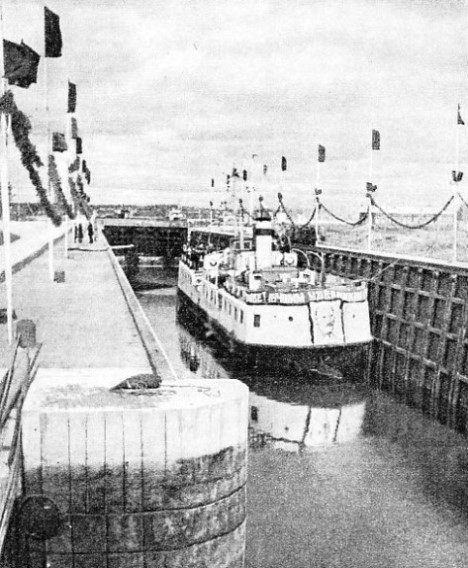 The free officials had conferences with the prisoner-
The free officials had conferences with the prisoner-
ONE OF THE LOCKS, of which there are nineteen, in the White Sea Baltic Canal. The summit of the canal is 354 ft. 4 in. above sea level. There are twelve locks between Soroka and the summit and a staircase of seven locks between the summit and Lake Onega.
Because of the long winter months much of the work had to be hurried forward at all possible speed during the spring and summer. In the winter the earth dams could not be built, because the frozen soil would thaw in the spring and give way under the pressure of water. Piledriving was likewise impossible, as with the thaw the piles would be loosened and were liable to be swept away. The winter was devoted to preparing for the spring and summer work and to building roads and accommodation. There was quite enough to do to clear the rough ground.
It was decided to make the summit level of the canal 108 metres (354 ft. 4 in.) to take the waterway across the watershed. The difficulty lay in the abrupt rise near Lake Onega. Here has been built a staircase of seven locks. The other twelve locks are spaced between the top of this Povenchansk Staircase and the sea.
Vessels enter the canal at Soroka and proceed through the first section of the canal, the various locks raising them nearly 200 feet above sea level in about fifty miles. Then vessels steam through the second section of the ascent, comprising four lakes and a small river. This section raises vessels to about 300 feet above the sea in about sixty-
Lake Vyg was impounded by dams and the level of the lake was raised nearly 20 feet. Islands in the lake were submerged and five fishing villages were transferred to the new shore. Over sixty miles of the Murmansk Railway had to be shifted out of the way of the canal and relaid. More than 4,300,000 charges of explosive were used to blast a path for the canal through the rock, and more than 6,000,000 tons of granite were removed by this means.
On the southern slope of the watershed the ground was littered with boulders. These were lifted in nets and tumbled into carts drawn by horses. In the winter trees felled in the forest were carted on horse-
A Human Chain
The caissons for the cofferdams were of wood, and were huge timber crates which were filled with stones. One night the cofferdam which had been built across the River Vyg threatened to collapse. Below the dam was the unfinished canal, which was not ready to receive the water. The level of the impounded water had risen unexpectedly, had broken through the temporary earthen dam and was advancing towards the diggings. Men and women dashed to the workings when the alarm was given. They frantically filled bags with stones to repair the breaches in the dam. Some formed a human chain along which the bags were passed to those who thrust them into the breaches. Others threw boards across the tops of the threatened caissons under which water had collected, ran along these planks with wheelbarrows filled with stones and flung the stones into the caissons to weight them. After a terrific struggle that lasted for about eighteen hours the checked.
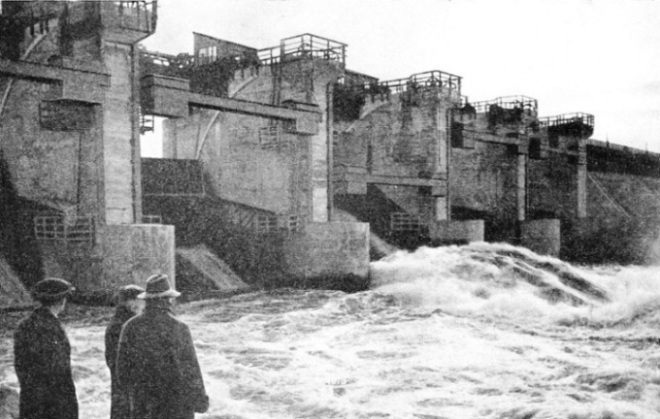
FLOODGATES IN THE CONCRETE AND TIMBER DAMS control the flood waters of the White Sea-
In the winter of 1932-
The authorities concentrated the best workers from all sections of the canal and aroused their enthusiasm by every means, even playing what they called “shock” workers to the site with a band. The great effort to avert disaster began on January 7, 1933, in bitter weather. The men toiled through snowstorms, and even if these ceased they had to contend with troubles such as quicksands, which filled trenches soon after they were dug. At one time no fewer than 30,000 workers were packed into a stretch of workings less than four miles long. They worked night and day, the workings being illuminated at night. Then the spring thaw began. But the toilers were on time, and the water was let into the vital section on April 23, 1933.
The weir for the great Shavansk Dam was built with considerable difficulty. The engineer sent to the site found when he arrived that the position indicated on the map was impossible because of the nature of the soil, and he searched until he found a site where a rocky projection offered a natural base. The river was cut off by a cofferdam and the excavation for the weir began. When the boulders were removed and the diabase (basaltic greenstone) was uncovered, a flaw was found in the rock at the deepest part of the basin, so that there was a possibility of the water penetrating the rock after the weir had been completed. The use of concrete solved this trouble. The wooden caissons were loaded, large stones being put in first, then rubble, gravel, sand and turf, and then a final layer of gravel and sand. The weir was faced with timber. Carpenters made a neat job of this, working with such exactitude that the final covering is so smooth that the water pouring over it resembles a sheet of glass and the cascade appears to be frozen motionless.
Waterfalls Silenced
Elsewhere the unskilled workers found the diabase such a hard rock to drill that they fell behind schedule until they learned to dig a trench, attack the rock from below and blow it up, instead of wasting energy by trying to bore through the hard upper layers from the top.
When the work began the Karelian peasants stood aloof. When river after river was dammed and the waterfalls were silenced, they became alarmed at this interference with Nature. Then the authorities sent agents who explained the object of the project, and some of the peasants volunteered to work alongside the prisoners.
Grass was planted along the canal banks, the sides of the locks and dams were laid with turf, and young pine trees were planted. A great five-
In one year about 3,000,000 tons of freight passed from north to south. The canal has given the district an outlet for its timber and immense natural resources. The timber is used for large-
The dams are being utilized to provide electrical power, and the intention is to develop the entire area by means of what the Russians call a Combinat, a group of kindred industries.
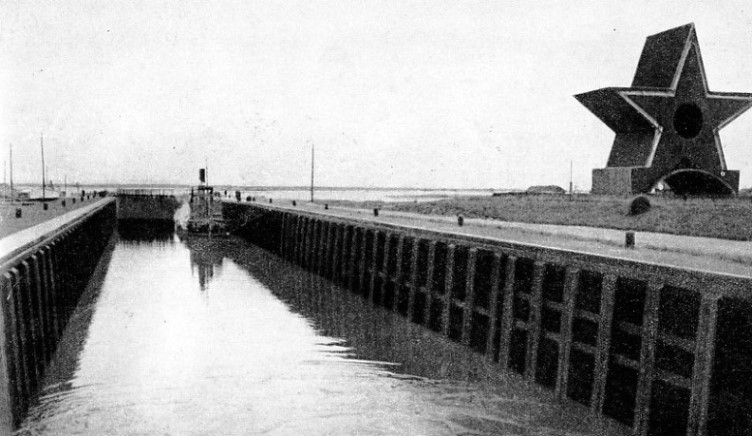
THE FIRST LOCK on the White Sea-
You can read more on “Canals Across Sweden”, “Moscow’s Great Canal” and “The Trans-
